Japan is a beautiful country with something for everyone. If you love exploring the breathtaking countryside and experiencing the nightlife of one of the biggest cities in the world, Japan should be on your destination list. Along with every corner of this country comes its smaller inhabitants; invertebrates.
While Japan does have its fair share of scary insects like the Japanese hornet, the arachnids of the country shouldn’t give you nightmares. Remember, every living being is just trying their best to get by, just as we are. Even a monstrous hornet doesn’t want to waste time on you and your nonsense. They are on their secret missions, and as long as you treat creatures with respect, including giving them plenty of space to not feel threatened, you will be fine.
Other than the infamous Redback spider, you will not need to worry about venomous arachnids. Keep in mind that spiders do like to hide and avoid humans as much as possible. Something as simple as shaking out your top bedsheets can keep you and spiders from coming face-to-face. Now, let’s explore the world of Japanese spiders.
Spiders in Japan
There are over 50,000 spiders worldwide, and that’s just the ones that have been identified and named. More are discovered all the time. It’s safe to say that this brief list of the most terrifying spiders in Japan doesn’t even come close to reflecting anywhere near as many as live there. If you do not want to be bitten by a spider, there are a few excellent ways to make that reality. Do not corner, mess with or threaten a spider. All bites are out of self-defense. If a spider feels threatened, it will threat-pose with its legs in the air or may play dead, making itself as small as possible. We are giants to any arachnid. Just think of how terrifying we must be to them.
If you need to remove a spider from inside, put a cup or bowl over it quickly and carefully slide a piece of paper under the container. Then take it immediately outside and release it. Another good measure for bedtime is to shake out your top blankets before getting in. If you trap a sleeping spider under a blanket by your leg, there’s a chance you’ll scare or hurt it, causing it to bite out of defense.
1. Redback Spider (Latrodectus hasseltii)
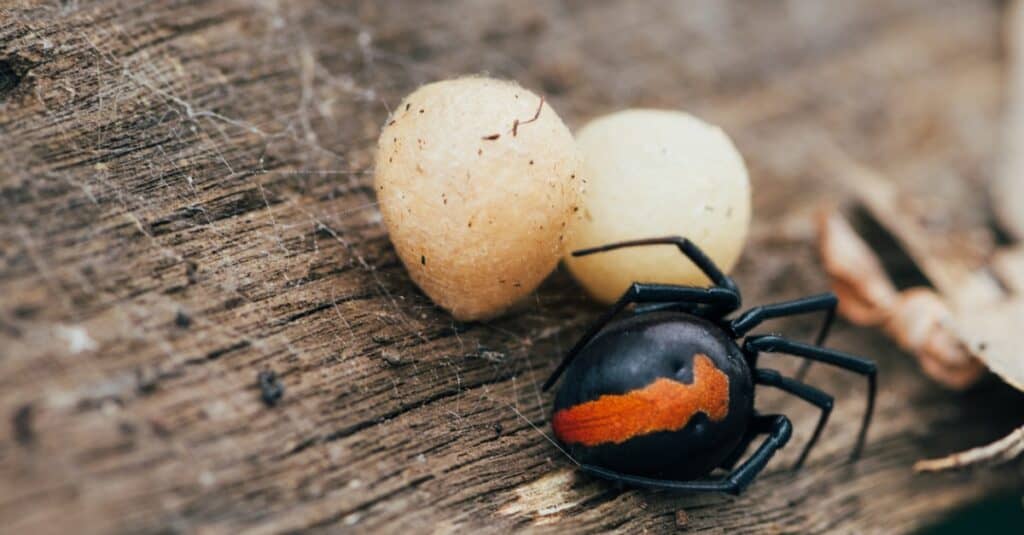
A Redback spider and her eggs saks.
©anystock/Shutterstock.com
The Redback spider is native to Australia, not Japan. This tiny spider has hitchhiked all over the world through the exportation of grapes and is now widespread across Japan. Redback spiders get a bad rap, but they rarely cause serious problems. Their bite can be excruciating and cause swelling and joint pain. In severe cases, the bite can cause heart palpitations, blood pressure changes, difficulty breathing, and vomiting.
The commonly known and feared Black Widow spider is in the same family as the Redback spider. Their appearances are very similar, as are their bite symptoms. They exhibit a reddish hourglass on the underside of their abdomen. These pea-sized black spiders prefer to be tucked away out of site and avoid humans. In a place as populated as Japan, hiding somewhere without humans isn’t easy in most areas. They prefer warmer temperatures, so moving into the heated homes of Japan works for them. Although, they can survive freezing temperatures, as seen in Japan, by going into a type of hibernation.
2. Joro Spider (Nephila clavata)

The Joro spider is known for being scary since it
balloons down
from the sky using its web when relocating due to environmental issues, such as flooding or when slings leave the nest.
©iStock.com/LizMinkertJohnson
The Joro Spider’s name in Japanese is “jorō-gumo,” which translates into entangling or binding bride. There is quite a bit of superstition surrounding these spiders and their myth. The Japanese myth says that a Joro spider has mind control over other spiders, can breathe fire like a dragon, and also turn into a beautiful woman who hunts and eats unsuspecting men. The legend says that the spider/woman might collect hundreds of bodies of men she has feasted on in a condemned house or other abandoned structure.
The Joro spider is a pretty orb weaver with yellow, back, and grey coloring. They have a bit of red on their abdomen, as well. Its long spindly black and yellow striped legs help it quickly cross its large ornate web. Though their body length is approximately one inch, the females’ leg span is four inches. These spiders are timid and afraid of humans. Their bite is harmless.
3. Pantropical Huntsman Spider (Heteropoda venatoria)
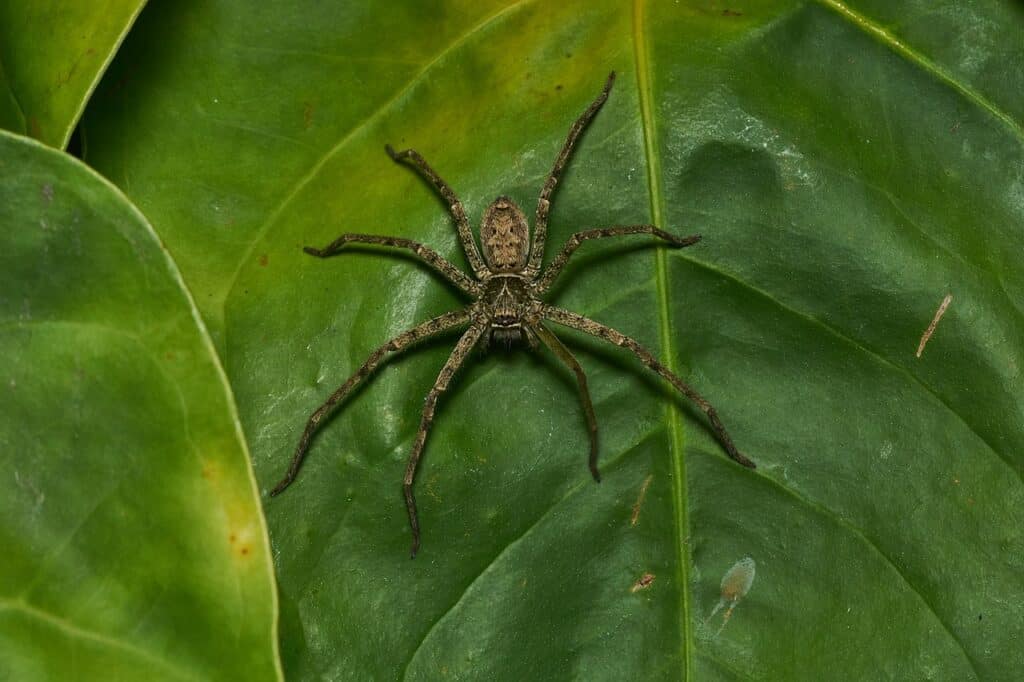
Some Pantropical huntsman spiders can measure nearly 12 centimeters long with their legs extended.
©© 2017 Jee & Rani Nature Photography / CC BY-SA 4.0 via Wikimedia Commons – Original / License
Pantropical Huntsman Spiders can be found all over the world. They seek areas with warm, moist tropical climates. The Pantropical Huntsman spider is sometimes called a banana spider since it likes to hitchhike in banana leaves. It’s also called the giant crab spider because of its long front. The legs are often held out to the side of the spider’s body, giving it the appearance of a crab.
The adults have an inch-long flat brown body with black spots, and their leg span can reach four inches. The female spider carries her egg sac in her pedipalps near her face until they hatch. Their lifespan is from one to two years, with the females tending to live the longest.
4. Giant Golden Orb Weaver (Nephila pilipes)
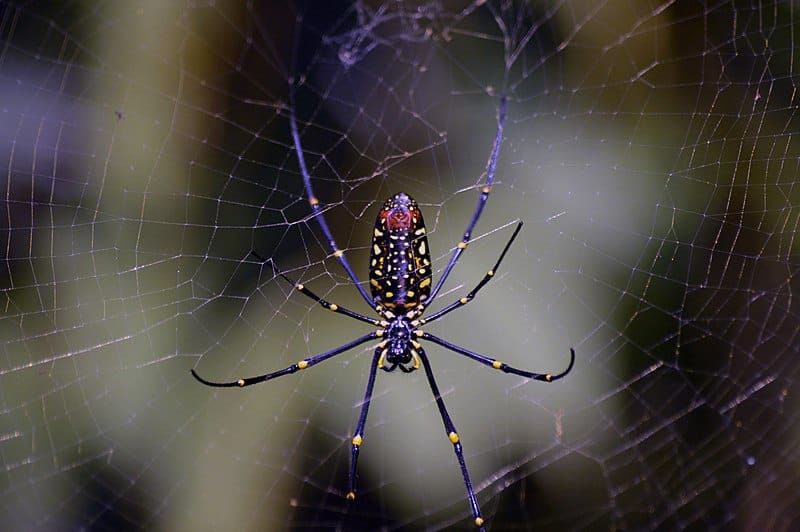
The Giant Golden Orb Weaver is often mistaken for the Joro spider.
Giant Golden Orb Weavers are large beautiful black and yellow garden spiders. They are similar to the Joro in that they are very shy and from the same family, Nephila. They are sometimes also called giant crab spiders due to their stance and size. These harmless spiders make large symmetrical orb-shaped white webs spanning several feet between bushes and trees.
The Giant golden orb weaver tends to stretch their massive webs nearer to the ground than that or its cousin, the Joro spider. A few minor differences exist between the golden orb weavers and the Joros. The giant golden orb weavers are a bit longer in body length than the Joros. The golden orb weavers have fuzzy “socks” on their back legs, whereas Joros do not. Both do an excellent job catching many insects and wrapping them up in their webs for later meals, a bit like meal prepping.
These and Joro spiders (and many other spider types) use ballooning to fly from place to place. Mostly, this is done when slings are ready to leave the nest and search for their very own homes. Many spiders use this technique to travel, though the spiders are generally tiny. Remember the end of the animated movie Charlotte’s Web, when most of Charlotte’s children fly away on a wind current?
5. Wasp Spider (Argiope bruennichi)

The Wasp Spider belongs to the family Argiope, which includes writing spiders.
©Greens and Blues/Shutterstock.com
The Wasp Spider is one of Japan’s most common and recognizable spiders. The female’s body looks almost like a piece of candy drizzled with white and yellow chocolate. Some say their coloring looks like a native wasp, and that is why they are named as such. They are not very large at a little over half an inch body length, with the males being about half their size and brown.
The wasp spider makes its webs early in the morning, hoping to catch insects that fly by throughout the day. Their webs are unique because they create a zigzag down the center of the large orb web that reflects UV light and insects. The zigzag line is called a stabilimentum.
6. Pantropical Jumping Spider (Plexippus paykulli)

The Pantropical Jumping Spider is a small, curious, and harmless spider.
©Macronatura.es/Shutterstock.com
The Pantropical Jumping Spider is a small species of jumping spider at less than half an inch long. The females have a tan stripe down the center of their brown bodies. The males are black and have a white stripe down their length and two white spots on their abdomen. These tiny spiders are very friendly and may even hop over to get a closer look at you.
The pantropical jumping spider does not make a web. Instead, they make very small hammocks that cradle their body. These hammocks are quickly put up as evening draws near since these spiders hunt during the day. The arboreal spiders hunt in trees, plants, and on the ground. They catch insects by stalking their prey and pouncing with a single jump, which is many times longer than they are.
7. Bird-Dropping Spider (Celaenia excavata)
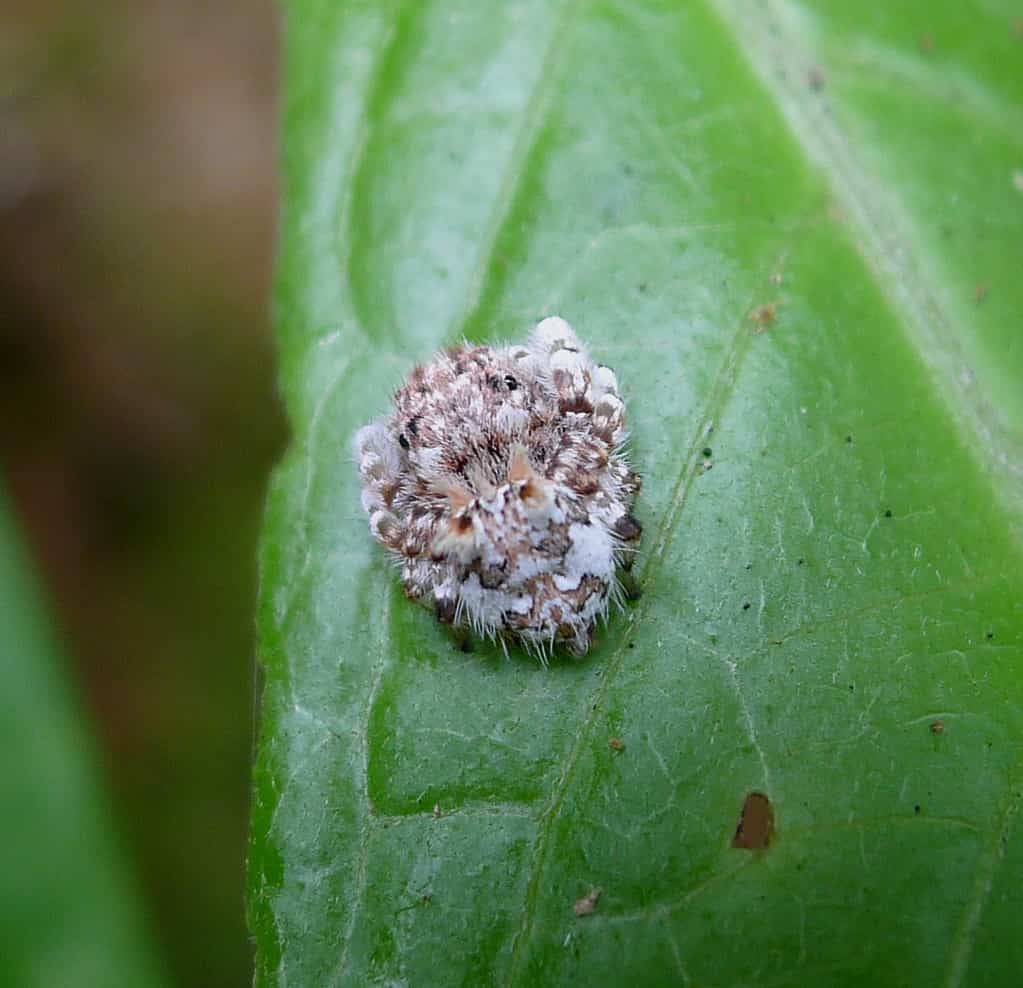
Bird-Dropping Crab Spider (Celaenia excavata) disguises itself as bird poop in order to trick predators and prey.
©gailhampshire from Cradley, Malvern / U.K, CC BY 2.0 – Original / License
The Bird Dropping Crab Spider is a small crab spider with a stinky trick to trick everyone. This little spider mimics bird droppings in appearance and smell! Some insects in the tropical rainforests of Japan are tricked into believing this hidden threat is no more than some bird poop and walk right into its trap. Some other insects seek the bird-dropping crab spider out to lay their eggs in the falsely advertised bird poop. These tiny spiders sometimes stay on the same leave tricking everyone for their entire lives.
The bird-dropping crab spider’s appearance is that of bird poop. It’s black and white, oddly shaped with some lumps. Appetizing, right? To fully dress the part, these less than half-inch-long spiders tend to keep their legs curled up underneath themselves. Also, their bite is harmless to humans.
8. Pointillist Neoscona (Neoscona punctigera)

The Monkey Orb Weaver Spider in Japan (Neoscona punctigera) looks like a tiny monkey hanging from a branch.
©arian.suresh from Chennai, India / CC BY 2.0 – Original / License
The Pointillist Neoscona (Neoscona punctigera) or Monkey Orb Weaver Spider is a small, spiny brown or yellowish spider that frequently can be seen hanging from vegetation like a minuscule monkey. They have spiky hairs covering their legs, which they neatly fold underneath. Both females and males are under half an inch in length.
Sadly, these little harmless spiders are captured and put together, similar to dog fighting. People bet on who will win, and though this isn’t illegal, it’s exceptionally unkind. Kids in school enjoy doing this so much that the school administration has stepped in to end it. The female Pointillist Neoscona will not tolerate another female in her territory, and sadly, they will fight until one of them dies.
9. Multi-Colored Phintella (Phintelloides versicolor)
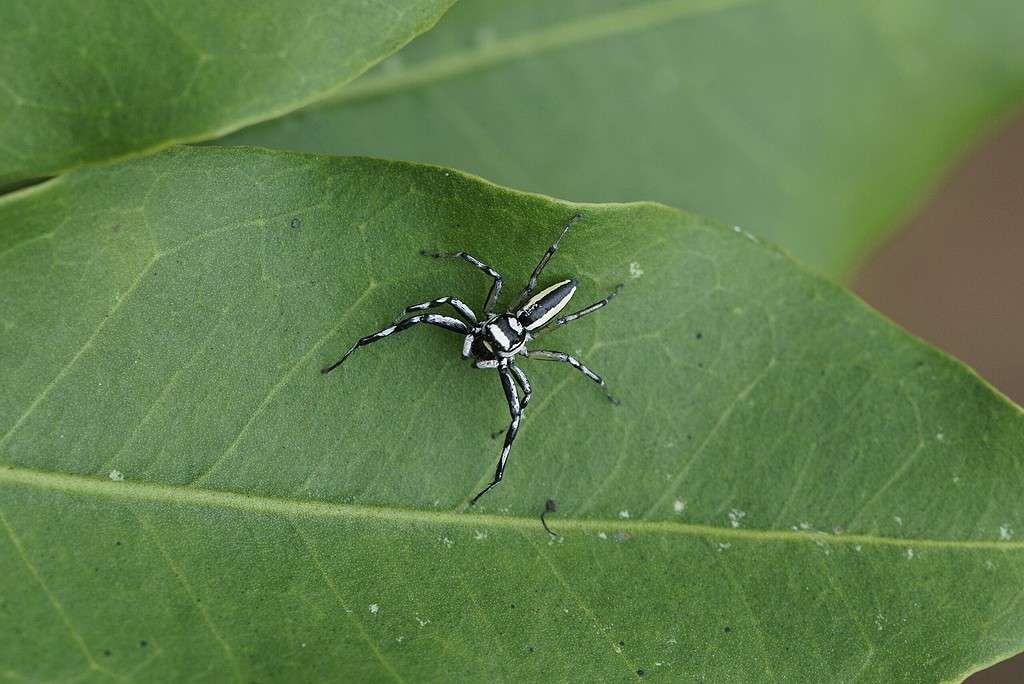
The Multi-colored Phintella Jumping Spider (Phintelloides versicolor) in Japan.
The Multi-colored Phintella Jumping Spiders are very tiny at a quarter of an inch long. They have a mighty jump that helps them catch small insects since they do not make webs to catch them. These spiders instead make tiny hammocks in which to sleep or molt. They can be black, cream, or brown with streaks of any of those colors, including red mixed in. Like all jumping spiders, they have enormous forward-facing eyes and fluffy pedipalps that clean their faces and bodies much like a cat.
The Multi-colored Phintella Jumping Spider can blend in with most surfaces with its varying colors. They can be found anywhere from homes to forest floors. These jumpers prefer warm tropical climates out of the way of rainfall.
10. Black and White Spiny Spider (Gasteracantha kuhli)

The Black and White Spiny Orb Weaver Spider (Gasteracantha kuhli) is a unique-looking arachnid with spikes.
The Black and White Spiny Orb Weaver Spider is a strange and alien-like lifeform in the arachnid population. These tiny spiders look so odd that you might mistake them for something entirely different. The females wear a type of armor with their hard exoskeletons with six points and look like they are going into battle. The males do not have spikes but have bumps. They are both very small at a quarter of an inch wide. The spots on their backs look similar to an inkblot test, and people can see just about anything on their backs.
Predators tend to shy away from prey with spikes, so the spider’s armor really is there to keep them safe. These orb weavers make webs in bushes generally and wrap their prey up snuggly before consuming.
11. Diving Bell Spider (Argyroneta aquatica)
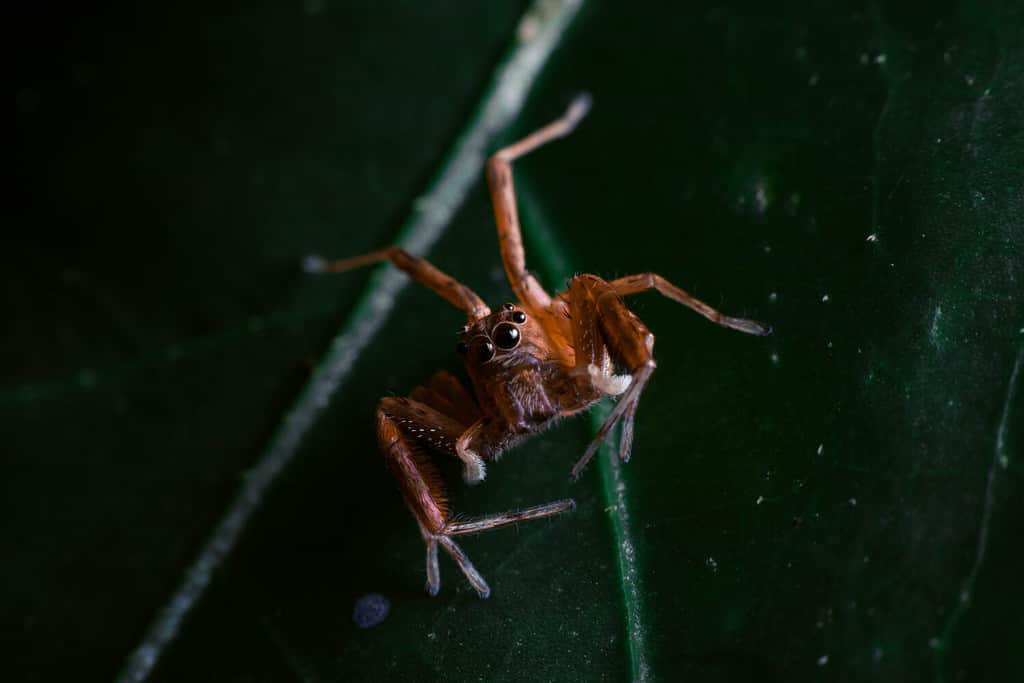
The Diving Bell Spider (Argyroneta aquatica), also known as the underwater spider, is the only aquatic species of spider in the entire world.
©RajatHegde/Shutterstock.com
The Diving Bell Spider is unique because it is the only arachnid that lives almost its entire life underwater. It comes up only to replenish its air supply once a day and dives back down again. These are a small species of spider that only reaches nearly half an inch in length. The adult males are a bit bigger than the females of this species. They are also faster divers due to their larger mass than the females. They appear silvery underwater due to the air bubbles caught on their fine hairs. Above water, they are black or dark colored and covered in fine hairs.
The diving bell spider attaches a bubble nest to underwater vegetation and tends to dine on mosquito larvae and other water insects. Each time the spider surfaces for air, it brings the breath of air down and distributes it in its bubble nest, where it can come back to for air without resurfacing.
12. Samurai Spider (Agriope amoena)
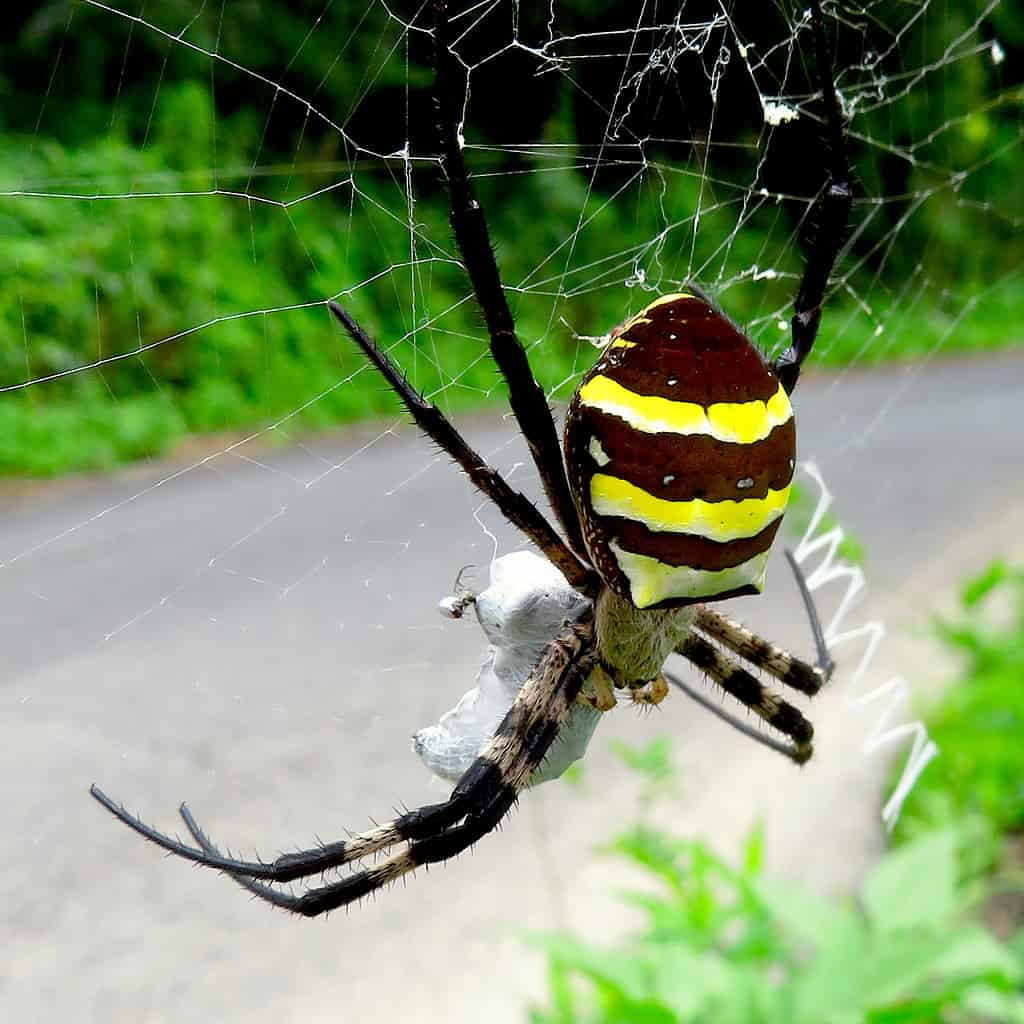
Samurai Spider (Argiope amoena) on a web in Japan.
©KKPCW / CC BY-SA 4.0 – License
The Samurai spider has a strange life in Japan as a fighting competitor and pet. People in Japan raise these spiders, train them and sometimes allow them to free-roam in their homes. During the month of June, Japan partakes in Kumo Gassen, which translates into Spider Battles. This tradition dates back 400 years, and though it’s inhumane, it remains legal. The rules for the fight between the purple and yellow spiders are simple. The winner has to snap the other’s web, bite first or wrap the opponent in webbing. The judges watch closely and do not let the spiders harm one another.
In North America, these spiders are also part of the garden spider family and are pretty standard. Since they are in the writing spider family, these spiders create a zigzag x in the center of their large webs. This helps to attract prey insects. They prefer to live in paddy fields, plains, and gardens and are found on the four smaller Japanese islands; Honshu, Shikoku, Kyushu, and Okinawa. Samurai spiders are approximately one inch in body length.
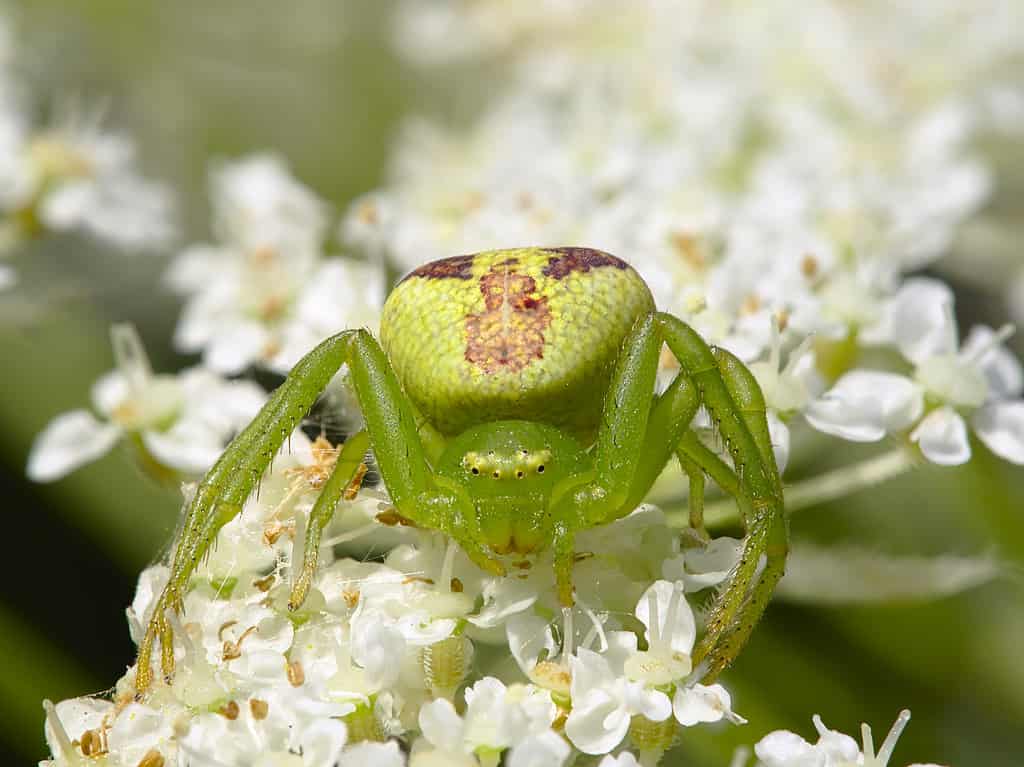
The tiny Triangle Crab Spider (Ebrechtella tricuspidata) in this photo is a female.
The Triangle Crab Spider is tiny at 3-6mm in size. The females are light green with white and red markings on the top of the abdomen. The males are usually golden brown with a green and white upper abdomen. These tiny spiders prefer the dryer, sunny areas of woodlands and meadows. The coloring of these spiders allows them to lay waiting inside flowers to catch their meals.
The triangle crab spider does not make a traditional web but lives inside flowers and plants. The browns and greens on their bodies help them blend in with the stems of plants. Their tiny but lengthy arms look much like a crab’s, which gives them their name.
14. Small Thief Spider (Argyrodes miniaceus)

Similar to the Argyrodes miniaceus discussed in this article, the Argyrodes fissifrons in a Small Thief Spider.
©張凱 / CC BY-SA 4.0 – License
The Small Thief Spider is literally a small thief. It is tiny at 3.5mm long and spends days hanging out on the edges of an orb weaver’s web, waiting for scraps from tiny insects. Given its small size, it is also pretty keen on stealing already-wrapped victims from the orb weaver. The species Argyrodes is also known as a tangle web spider or comb-footed spider. The small thief spider is bright orange and cone-shaped. Pictured is a cousin of the Argyrodes miniaceus, the Argyrodes fissifrons, which in this photo above is a brown cone-shaped comb-footed spider.
Though these little co-habitators are thieves, they can benefit their host spider by eating the leftover scraps of prey and removing them from the web. Sometimes, these little thieves turn on their hosts as thieves often will and can even kill and eat them. Not a great Spider Air BnB guest.
15. Comb-Footed Spider (Rhomphaea hyrcana)

Rhomphaea urquharti is similar to the spider discussed in this article, the Comb-Footed Spider (Rhomphaea hyrcana)
The Comb-Footed Spider, sometimes called the cobweb spider, is not harmful to humans, but the tiny hairs on these little spiders can irritate the skin. They are sometimes referred to as tangled web spiders because their messy webs appear to be tangled up. These spiders are very small at less than a quarter inch long. They are brown and easily overlooked, which makes them good at hiding in homes. The spider is called comb-footed because it has small comb-like hairs along its fourth foot.
These slight spiders do not cause problems or wander around in your home. They stick to their quiet webs and feast on small insects that land in their webs.
The photo featured at the top of this post is © iStock.com/Windy Soemara
Thank you for reading! Have some feedback for us? Contact the AZ Animals editorial team.







